Shichimi Togarashi is easy to make at home and means you get maximum flavor in every batch. The freshly toasted sesame seeds and chile flakes hit way harder than the stuff that's been sitting on a store shelf! Sprinkle this bold seasoning on everything, not just your favorite Japanese dishes. Think roasted and grilled vegetables, rice, tofu, popcorn, fries, chips, hummus, avocado toast, and more!
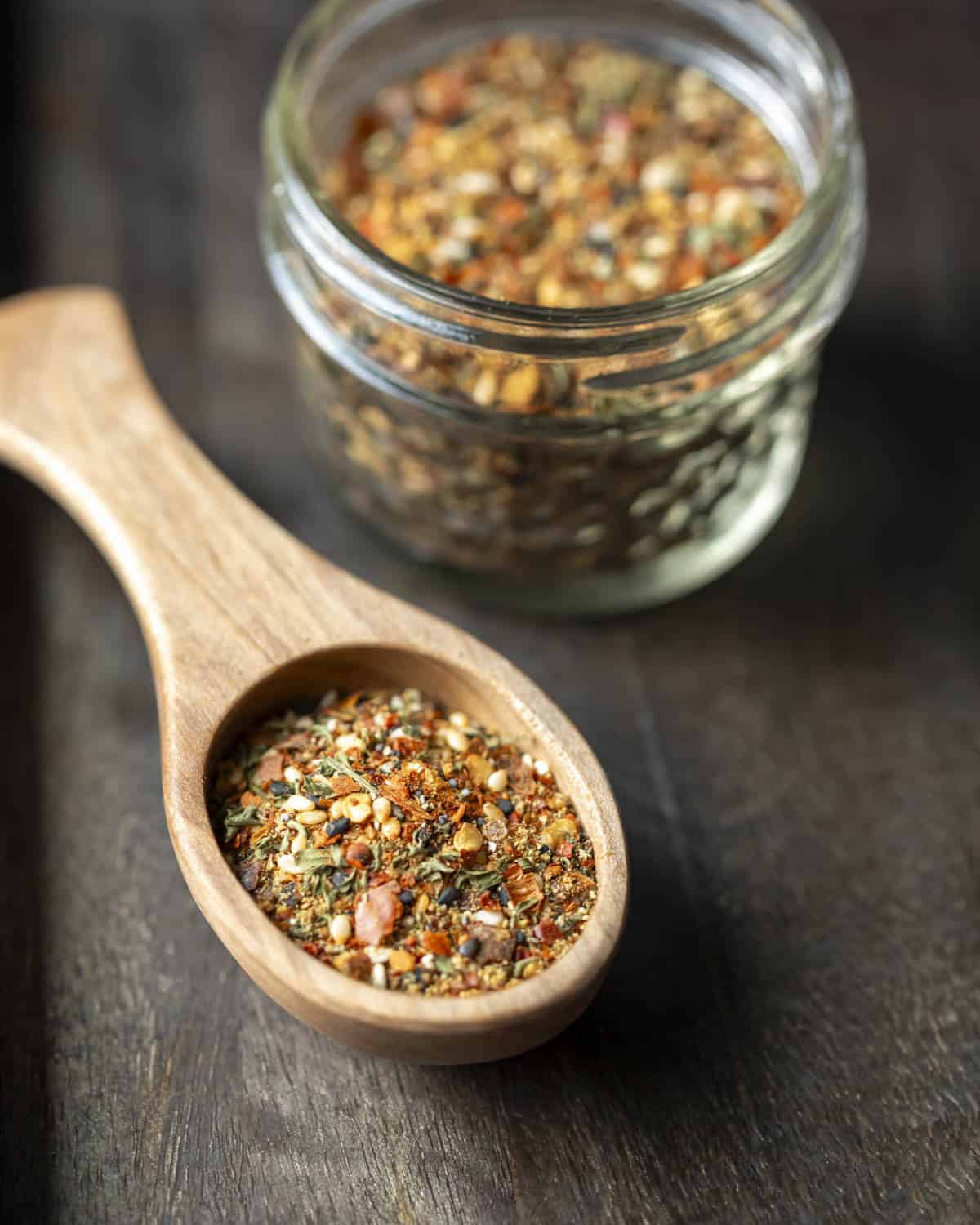
If you've ever had a bowl of ramen or udon that seemed to have a little extra magic, it was probably thanks to the popular Japanese seasoning Shichimi Togarashi.
If you already love spice blends like za'atar or berbere, you'll definitely appreciate the way shichimi togarashi hits that same sweet spot of flavor layering. Plus, as a salt-free seasoning, it's a fantastic way to add tons of flavor to your meals and snacks without adding a lot of sodium.
What Is Togarashi?
The word togarashi simply means "chili pepper" in Japanese, so you'll often see it pop up in different spice blend names. There are actually a few types of togarashi, but the one we're preparing here is called Shichimi Togarashi - "shichimi" meaning "seven flavors." It's a classic Japanese 7-spice mix made with chili flakes, citrus peel, sesame seeds, seaweed, and a few other flavorful bits.
You might also come across "Nanami Togarashi." Both nanami and shichimi translate to "seven flavors," but "nanami" is often used in branding because it's easier to pronounce. Sometimes nanami is used to refer to blends that contain less, or no, dried citrus peel.
Don't be confused by Ichimi Togarashi on store shelves, which is simply pure red chili flakes, with none of the other tasty additions. Basically, ichimi togarashi is the key ingredient in shichimi togarashi.

Ingredients & Substitutions
I wanted to create a homemade version that skips the hard-to-find ingredients (where possible), but still hits all the right notes. Feel free to tweak the recipe to suit your needs.
Red chile pepper flakes - Ichimi togarashi is the authentic choice but may not be easy to find. I often use a combination of gochugaru (Korean red chile flakes) and whatever other variety of spicy red chile I have in the pantry. Or start with whole dried chiles, which break down easily in a spice grinder or blender.
Sansho or Sichuan peppercorns - These two types of peppercorns are related and lend citrusy and floral notes to the mix. Note that Sansho is milder and has less of the mouth-numbing effect that Sichuan peppercorns are known for. Sansho are Japanese and the authentic option here, but Chinese Sichuan (or Szechuan) peppercorns tend to be easier to find. Sub pink or black peppercorns if you must (use less since they are spicier), but know that you'll be missing out on the unique aroma and slight numbing effect.
Dried orange peel - Probably my favorite aspect of this seasoning, citrus adds bright and sweet aroma and a slightly bitter taste. Yuzu or mandarin are the more authentic choices, but not as easy to get here in the US.
🍊Tip! In keeping with the small-batch theme, you can easily dry the peel of an orange at home, if that's more convenient (more on this below).
Sesame seeds: Both white and black sesame seeds are often included. Hemp seeds and/or poppy seeds can also be incorprated. To keep things simple, I went with sesame seeds only.
Nori or aonori: Dried seaweed adds great umami to the mix. If you don't have nori, dried kelp or dulse flakes are usually easy to find in stores and add a subtle, hint of the sea.
Optional: Ground ginger lends warming, savory notes. Dried parsley adds color and soft herbal notes. Though parsley isn't always found in shichimi blends, one of the first brands I ever tried included it. So I usually do, as well.
How to Make Shichimi Togarashi
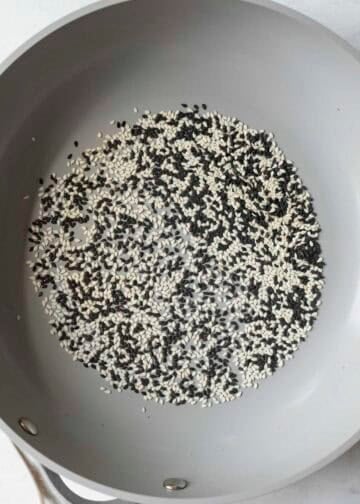
First, dry toast the sesame seeds over medium-low heat until the white sesame looks tan and lightly toasted. Stir frequently so they don't burn. Transfer to a plate to cool.
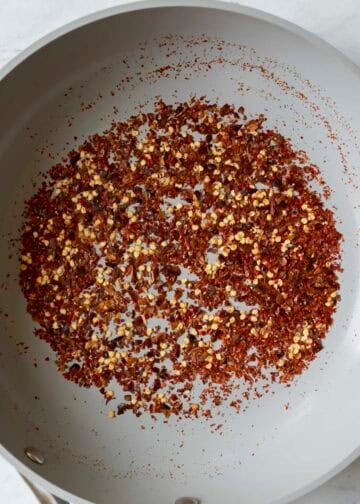
Next, toast the chili flakes for a minute or two, continuing to stir. Once nice and fragrant, transfer to the plate.
Want to save this recipe? 📩
Keep an eye out for more delicious recipes. Unsubscribe anytime.
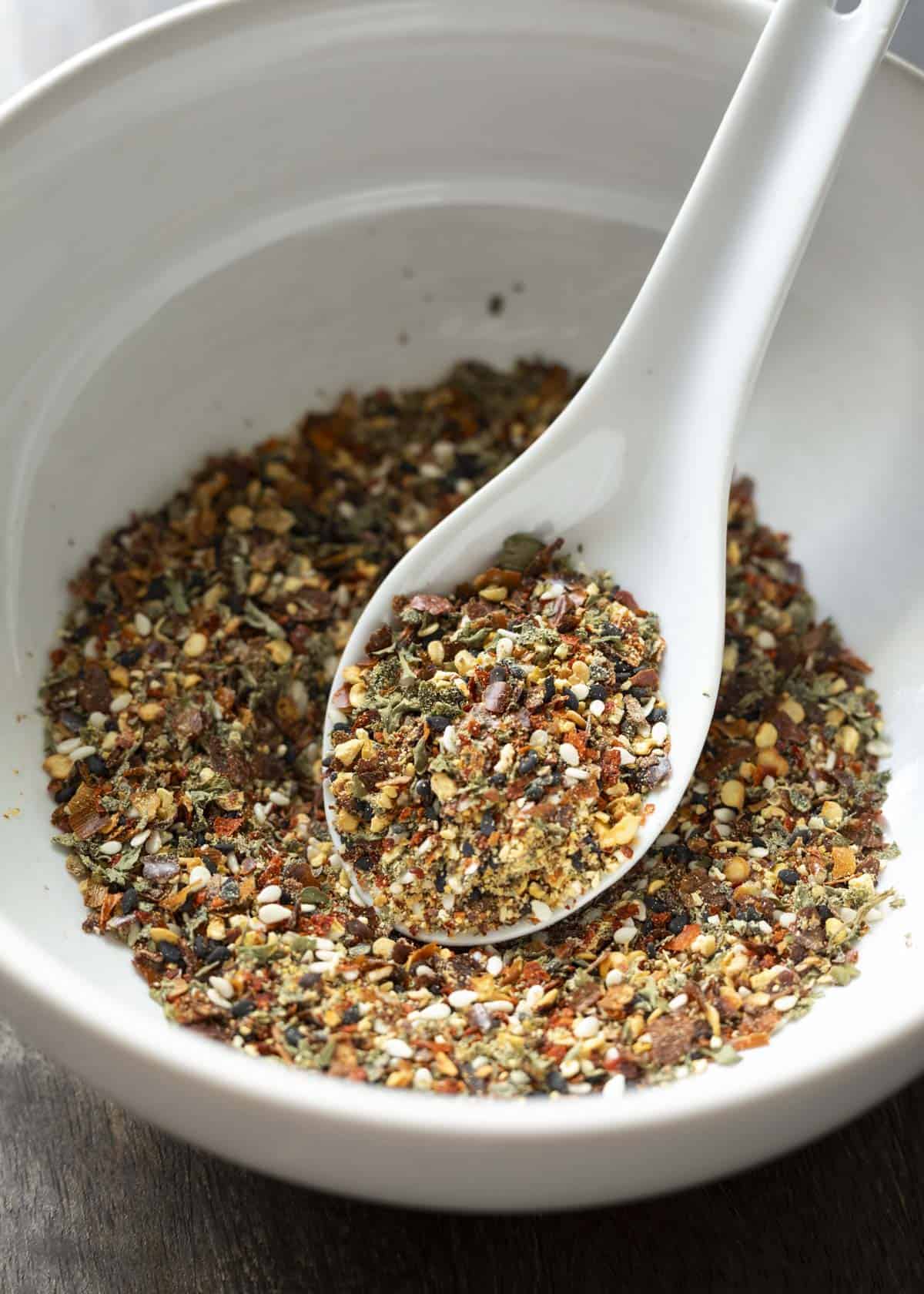
While the seeds and chile flakes are cooling, use an electric spice grinder to break down the peppercorns and orange peel if you haven't already.
This is up to you, but if you'd like some whole sesame seeds in the finished seasoning, set half of them aside. Add the rest of the seeds to the spice grinder along with all of the other ingredients. Pulse until coarsely ground, with some larger bits remaining. You may need to work in batches.
Pictured above is what it looks like mixed together (minus half of the sesame seeds), before being blended.
How to Dry Orange Peel
Dried citrus peel is one of the more hard-to-find ingredients in this recipe. Luckily, it's easy to make at home, and the peel from just one orange will give you enough for a couple of small batches of shichimi.
Wash and dry your citrus very well. With a good paring knife or peeler, try to get mostly peel, avoiding as much of the bitter white pith as possible. Then leave it out to air dry for several days or use a dehydrator.
For a faster option, check out this post over at 101 Cookbooks to learn how to dry citrus peel in the oven.
Variations
- Other Citrus: Switch things up with grapefruit or lemon peel instead of orange or mandarin.
- Make It Smoky: For a subtle smoky twist, use chili peppers that naturally have a smoky flavor, like ancho or guajillo. You can also swap some of the red pepper flakes for smoked paprika. It's a great way to add depth and tone down the heat if you prefer a milder blend.
Fun Ways to Use Shichimi Togarashi
Okay, this is a bit long, but I can't help myself! It's just such a versatile seasoning. Here are some of my favorite uses:
- Popcorn, Nuts & Chips - Sprinkle it on freshly popped popcorn, roasted nuts, savory granola, and homemade healthy tortilla chips and potato chips.
- Edamame, Tofu & Tempeh - It's a slam dunk on this air fryer edamame, and this togarashi tofu scramble is a delicious way to start the day.
- Noodles, Rice & Soups - Add to ramen, miso soup, soba noodles, and rice bowls. It wakes everything up with a jolt of flavor and crunch.
- Roasted Veggies and Potatoes - Toss broccoli, Brussels sprouts, or sweet potatoes with a little oil and shichimi before roasting-or just hit 'em after with a finishing sprinkle.
- Vegan Sushi or Poke Bowls - Adds a perfect savory-sweet heat to your tofu poke bowls and veggie sushi rolls.
- On Avocado Toast - Add a squeeze of lime or lemon and a pinch of this spice blend on the avocado. Top it off with your favorite salt.
- Togarashi Mayo - Stir it into vegan mayonnaise for an epic hot-and-cool condiment!
- With Soft Cheeses - Sprinkle it on vegan cottage cheese and swap it for the herbs in this vegan Boursin.
- Salad Dressings & Marinades - Mix it into vinaigrettes, tahini dressing, or soy-based marinades for a savory-spicy edge.
I just finished snacking on popcorn seasoned with both za'atar and togarashi. The two together are chef's kiss! 🙌
Frequently Asked Questions
This can vary depending on the blend. You'll notice the nutty taste of sesame bring balance to the spicy chile flakes. Depending on the amounts used, next may be sweet citrus and floral notes thanks to the dried peel and peppercorns, followed by the smooth umami of nori.
Store your homemade shichimi togarashi in a small glass jar or spice tin in a cool, dry place for up to 2 months.
A Few Tips
- Heat level: You're in control of the fire. Add more chili flakes if you like it hot, or dial it down for a more citrus-forward blend.
- Texture matters: Don't over-grind it. That little bit of crunch from the seeds and seaweed makes it extra special.
- Try a sweet spin: Sprinkle a tiny bit on dark chocolate, rice pudding, or vanilla ice cream. Sounds weird but tastes amazing!
More Seasoning Blends
Do you have a favorite way to use shichimi togarashi? Share it with us in the comments!
Recipe
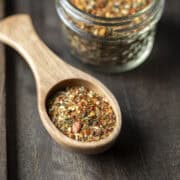
Shichimi Togarashi Recipe
Equipment
- electric coffee/spice grinder - or mortar and pestle
Ingredients
- 1½ teaspoons white sesame seeds - or hemp seeds
- 1½ teaspoons black sesame seeds
- 1½ Tablespoons red chile flakes - see Notes
- 2 teaspoons powdered dried orange peel
- half sheet toasted nori - or 2 teaspoon nori flakes
- ¾ teaspoon Sansho or Sichuan peppercorns
- ½ teaspoon dried parsley, optional
- ¼ teaspoon ground ginger, optional
Instructions
- Preheat a skillet over medium-low heat. Dry toast both types of sesame seeds for about 2 minutes, stirring frequently so they don't burn. Once the white sesame is slightly darker in color, transfer the seeds to a plate to cool.
- Toast the chile flakes for 1-2 minutes, stirring so they don't burn. Once fragrant, transfer to the plate with the sesame seeds.
- While the seeds and chile flakes cool, use an electric spice grinder (coffee grinder) or small blender to grind the peppercorns and dried orange peel, if you haven't already.
- Set aside about half of the sesame seeds. Add the rest to the spice grinder along with all other ingredients-you may need to work in batches. Pulse until coarsely ground, with some larger bits remaining.
- Combine with the reserved whole sesame seeds and pour into a lidded jar or other storage container. Store togarashi seasoning in a cool, dry spot for up to 2 months.
Notes
- ¼ tsp garlic powder
- Swap the orange peel for dried mandarin or yuzu if you have it
Estimated Nutrition (per serving)
Nutrition information is an estimate and will vary depending on the exact amounts and specific products and ingredients used.



Comments
No Comments